| C H A P T E R 1 |
|
Configuring the System Console |
This chapter explains what the system console is, describes the different ways of configuring it on a Netra 440 server, and helps you understand its relation to the system controller.
Tasks covered in this chapter include:
Other information in this chapter includes:
To install your system software or to diagnose problems, you need some way to interact at a low level with the system. The system console is Sun's facility for doing this. You use the system console to view messages and issue commands. There can be only one system console per computer.
The serial management port (SERIAL MGT) is the default port for accessing the system console upon initial system installation. After installation, you can configure the system console to accept input from and send output to different devices. TABLE 1-1 lists these devices and where they are discussed in the document.
|
During Installation[1] |
||
|---|---|---|
|
A terminal server attached to the serial management port (SERIAL MGT) or ttyb. See the following: |
||
|
An alphanumeric terminal or similar device attached to the serial management port (SERIAL MGT) or ttyb. See the following: |
||
|
A TIP line attached to the serial management port (SERIAL MGT) or ttyb. See the following: |
||
|
An Ethernet line connected to the network management port (NET MGT). See the following: |
||
|
A local graphics monitor (frame buffer card, graphics monitor, mouse, and so forth). See the following: |
||
The system console displays status and error messages generated by firmware-based tests during system startup. After those tests have been run, you can enter special commands that affect the firmware and alter system behavior. For more information about tests that run during the boot process, refer to the Netra 440 Server Diagnostics and Troubleshooting Guide.
Once the operating system is booted, the system console displays UNIX system messages and accepts UNIX commands.
To use the system console, you need some means of getting data in to and out of the system, which means attaching some kind of hardware to the system. Initially, you might have to configure that hardware, and load and configure appropriate software as well.
You must also ensure that the system console is directed to the appropriate port on the Netra 440 server's back panel--generally, the one to which your hardware console device is attached (see FIGURE 1-1). You do this by setting the input-device and output-device OpenBoot configuration variables.
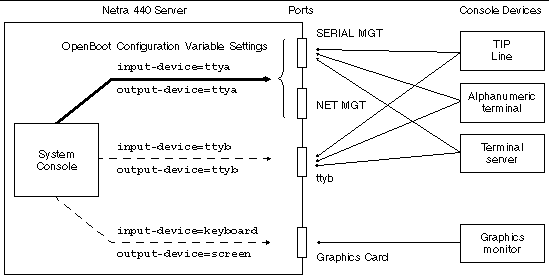
On Netra 440 servers, the system console comes preconfigured to allow input and output only by means of hardware devices connected to the serial or network management ports. However, because the network management port is not available until you assign it an IP address, your first connection must be to the serial management port (SERIAL MGT).
Typically, you connect one of the following hardware devices to the serial management port:
This provides for secure access at the installation site.
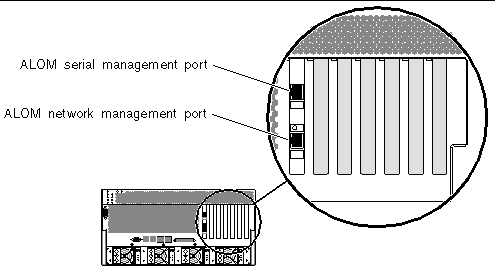
Using a TIP line might be preferable to connecting an alphanumeric terminal, since TIP lets you use windowing and operating system features on the machine being used to make the connection to the Netra 440 server.
Although the Solaris OS sees the serial management port as ttya, the serial management port is not a general-purpose serial port. If you want to use a general-purpose serial port with your server--to connect a serial printer, for instance--use the regular 9-pin serial port on the back panel of the Netra 440. The Solaris OS sees this port as ttyb.
Once you have assigned an IP address to the network management port (NET MGT), you can connect an Ethernet-capable device to the system console through your network. This provides for remote monitoring and control. In addition, up to four simultaneous connections to the system controller sc> prompt are available through the network management port. For more information, see Activating the Network Management Port.
In the default configuration, system controller alerts and system console output appear interspersed in the same window. After initial system installation, you can redirect the system console to take its input from and send its output to the serial port ttyb, or to a graphics card's port.
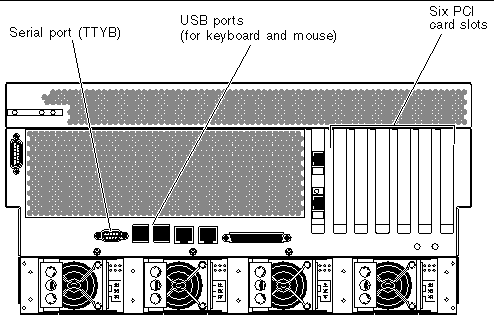 [ D ]
[ D ]
The chief advantage of redirecting the system console to another port is that it allows you to divide system controller alerts and system console output into two separate windows.
However, there are some serious disadvantages to alternative console configuration:
For all the preceding reasons, the best practice is to leave the system console in its default configuration.
You change the system console configuration by setting OpenBoot configuration variables. See System Console OpenBoot Configuration Variable Settings.
You can also set OpenBoot configuration variables using the ALOM system controller. For details, refer to the Advanced Lights Out Manager User's Guide (817-5481-xx).
The Netra 440 server is shipped without a mouse, keyboard, monitor, or frame buffer for the display of bitmapped graphics. To install a graphics monitor on the server, you must install a frame buffer card into a PCI slot, and attach a monitor, mouse, and keyboard to the appropriate back panel ports.
After starting the system, you might need to install the correct software driver for the PCI card you have installed. For detailed hardware instructions, see Accessing the System Console Through a Local Graphics Monitor.
|
Note - POST diagnostics cannot display status and error messages to a local graphics monitor. |
The ALOM system controller runs independently of the Netra 440 server and regardless of system power state. When you connect a Netra 440 server to AC power, the ALOM system controller immediately starts up, and begins monitoring the system.
|
Note - To view ALOM system controller boot messages, you must connect an alphanumeric terminal to the serial management port before connecting the AC power cords to the Netra 440 server. |
You can log in to the ALOM system controller at any time, regardless of system power state, as long as AC power is connected to the system and you have a way of interacting with the system. You can also access the ALOM system controller prompt (sc>) from the OpenBoot ok prompt or from the Solaris # or % prompt, provided the system console is configured to be accessible through the serial management and network management ports. For more information, see the following:
The sc> prompt indicates that you are interacting with the ALOM system controller directly. It is the first prompt you see when you log in to the system through the serial management port or network management port, regardless of system power state.
Up to five ALOM system controller sessions can be active concurrently, one session through the serial management port and up to four sessions through the network management port. Users of each of these sessions can issue commands at the sc> prompt. However, only one user at a time can access the system console, and then only if the system console is configured to be accessible through the serial and network management ports. For more information, see:
Any additional ALOM system controller sessions afford passive views of system console activity, until the active user of the system console logs out. However, the console -f command, if you enable it, allows users to seize access to the system console from one another. For more information, see the Advanced Lights Out Manager User's Guide (817-5481-xx).
There are several ways to get to the sc> prompt:
A Netra 440 server with the Solaris OS installed is capable of operating at different run levels. A synopsis of run levels follows. For a full description, refer to the Solaris system administration documentation.
Most of the time, you operate a Netra 440 server at run level 2 or run level 3, which are multiuser states with access to full system and network resources. Occasionally, you might operate the system at run level 1, which is a single-user administrative state. However, the lowest operational state is run level 0. At this state, it is safe to turn off power to the system.
When a Netra 440 server is at run level 0, the ok prompt appears. This prompt indicates that the OpenBoot firmware is in control of the system.
There are a number of scenarios under which OpenBoot firmware control can occur.
It is the last of these scenarios which most often concerns you as an administrator, since there will be times when you need to reach the ok prompt. Several ways to do this are outlined in Reaching the ok Prompt. For detailed instructions, see Getting to the ok Prompt.
There are several ways to reach the ok prompt, depending on the state of the system and the means by which you are accessing the system console. In order of desirability, these are:
A discussion of each method follows. For step-by-step instructions, see Getting to the ok Prompt.
The preferred method of reaching the ok prompt is to shut down the operating system by issuing an appropriate command (for example, the shutdown, init, or uadmin command) as described in Solaris system administration documentation. You can also use the system Power button to initiate a graceful system shutdown.
Gracefully shutting down the system prevents data loss, enables you to warn users beforehand, and causes minimal disruption. You can usually perform a graceful shutdown, provided the Solaris OS is running and the hardware has not experienced serious failure.
You can also perform a graceful system shutdown from the ALOM system controller command prompt.
Typing break from the sc> prompt forces a running Netra 440 server to drop into OpenBoot firmware control. If the operating system is already halted, you can use the console command instead of break to reach the ok prompt.
After forcing the system into OpenBoot firmware control, be aware that issuing certain OpenBoot commands (like probe-scsi, probe-scsi-all, or probe-ide) might hang the system.
When it is impossible or impractical to shut down the system gracefully, you can get to the ok prompt by typing the L1-A (Stop-A) key sequence from a Sun keyboard. If you have an alphanumeric terminal attached to the Netra 440 server, press the Break key.
After forcing the system into OpenBoot firmware control, be aware that issuing certain OpenBoot commands (like probe-scsi, probe-scsi-all, or probe-ide) might hang the system.
|
Note - These methods of reaching the ok prompt will only work if the system console has been redirected to the appropriate port. For details, see System Console OpenBoot Configuration Variable Settings. |
Use the ALOM system controller reset -x command to execute an externally initiated reset (XIR). Forcing an XIR might be effective in breaking the deadlock that is hanging up the system. However, an XIR also precludes the orderly shutdown of applications, and so it is not the preferred method of reaching the ok prompt, unless you are troubleshooting these types of system hangs. Generating an XIR has the advantage of allowing you to issue the sync command to produce a dump file of the current system state for diagnostic purposes.
For more information, refer to:

|
Caution - Because an XIR precludes an orderly shutdown of applications, it should only be attempted if previously described methods do not work. |
Use the ALOM system controller reset command, or poweron and poweroff commands, to reset the server. Reaching the ok prompt by performing a manual system reset or by power-cycling the system should be the method of last resort. Doing this results in the loss of all system coherence and state information. A manual system reset could corrupt the server's file systems, although the fsck command usually restores them. Use this method only when nothing else works.

|
When you access the ok prompt from a functioning Netra 440 server, you are suspending the Solaris OS and placing the system under firmware control. Any processes that were running under the operating system are also suspended, and the state of such processes might not be recoverable.
The diagnostic tests and commands you run from the ok prompt have the potential to affect the state of the system. This means that it is not always possible to resume execution of the operating system from the point at which it was suspended. Although the go command will resume execution in most circumstances, in general, each time you drop the system down to the ok prompt, you should expect to have to reboot the system to get back to the operating system.
As a rule, before suspending the operating system, you should back up files, warn users of the impending shutdown, and halt the system in an orderly manner. However, it is not always possible to take such precautions, especially if the system is malfunctioning.
For more information about the OpenBoot firmware, refer to the OpenBoot 4.x Command Reference Manual. An online version of the manual is included with the OpenBoot Collection AnswerBook that ships with Solaris software.
This procedure provides several ways of reaching the ok prompt. The methods are not equally desirable. For details about when to use each method, see OpenBoot ok Prompt.
If at all possible, back up system data before starting this procedure. Also exit or stop all applications and warn users of the impending loss of service. For information about the appropriate backup and shutdown procedures, see Solaris system administration documentation.
|
1. Decide which method you need to use to reach the ok prompt.
See OpenBoot ok Prompt for details.
2. Follow the appropriate instructions in TABLE 1-2.
|
|
The Netra 440 server features two management ports, labeled SERIAL MGT and NET MGT, located on the server's back panel. If the system console is directed to use the serial management and network management ports (its default configuration), these ports provide access to both the system console and the ALOM system controller, each on a separate "channel" (see FIGURE 1-4).
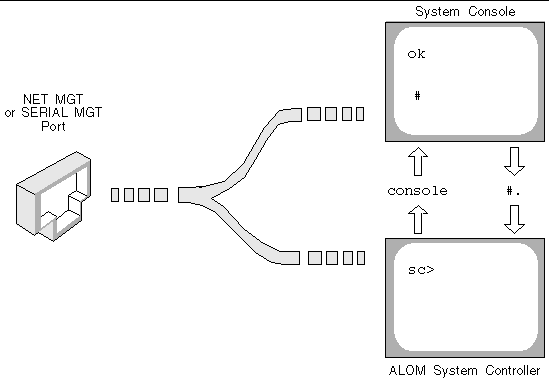 [ D ]
[ D ]
If the system console is configured to be accessible from the serial management and network management ports, when you connect through one of these ports you can access either the ALOM command-line interface or the system console. You can switch between the ALOM system controller and the system console at any time, but you cannot access both at the same time from a single terminal or shell tool.
The prompt displayed on the terminal or shell tool tells you which "channel" you are accessing:
To reach the system console from the ALOM system controller, type the console command at the sc> prompt. To reach the ALOM system controller from the system console, type the system controller escape sequence, which by default is #. (pound period).
For more information, see the following:
The following sections describe ways of accessing the system controller.
This procedure assumes that the system console is directed to use the serial management and network management ports (the default configuration).
When you are accessing the system console using a device connected to the serial management port, your first point of access is the ALOM system controller and its sc> prompt. After connecting to the ALOM system controller, you can switch to the system console itself.
For more information about the ALOM system controller card, refer to the Netra 440 Server Product Overview (817-3881-xx) and the Advanced Lights Out Manager User's Guide (817-5481-xx).
1. Ensure that the serial port on your connecting device is set to the following parameters:
2. Establish an ALOM system controller session.
See Advanced Lights Out Manager User's Guide (817-5481-xx) for instructions.
3. To connect to the system console, at the ALOM system controller command prompt, type:
The console command switches you to the system console.
4. To switch back to the sc> prompt, type the #. escape sequence.
For instructions on how to use the ALOM system controller, see the Advanced Lights Out Manager User's Guide (817-5481-xx).
You must assign an Internet Protocol (IP) address to the network management port before you can use it. If you are configuring the network management port for the first time, you must first connect to the ALOM system controller using the serial management port and assign an IP address to the network management port. You can either assign an IP address manually, or you can configure the port to obtain an IP address using the Dynamic Host Configuration Protocol (DHCP) from another server.
Data centers frequently devote a separate subnet to system management. If your data center has such a configuration, connect the network management port to this subnet.
1. Connect an Ethernet cable to the network management port.
2. Log in to the ALOM system controller through the serial management port.
For more information about connecting to the serial management port, see Accessing the System Controller.
3. Type one of the following commands:
4. Enter the following so that the new settings will take affect:
5. To verify the network settings, type:
6. Log out of the ALOM system controller session.
To connect through the network management port, use the telnet command to the IP address you specified in Step 3 of the preceding procedure.
The following procedure assumes that you are accessing the system console by connecting a terminal server to the serial management port (SERIAL MGT) of the Netra 440 server.
1. Complete the physical connection from the serial management port to your terminal server.
The serial management port on the Netra 440 server is a data terminal equipment (DTE) port. The pinouts for the serial management port correspond with the pinouts for the RJ-45 ports on the Serial Interface Breakout Cable supplied by Cisco for use with the Cisco AS2511-RJ terminal server. If you use a terminal server made by another manufacturer, check that the serial port pinouts of the Netra 440 server match those of the terminal server you plan to use.
If the pinouts for the server serial ports correspond with the pinouts for the RJ-45 ports on the terminal server, you have two connection options:
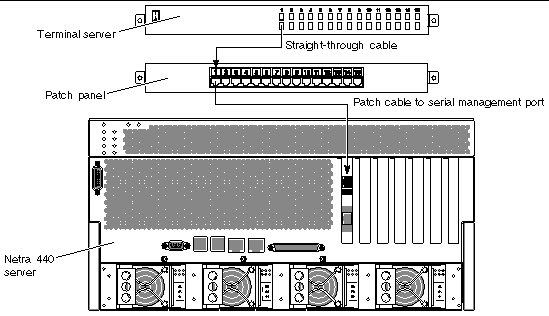
If the pinouts for the serial management port do not correspond with the pinouts for the RJ-45 ports on the terminal server, you need to make a crossover cable that takes each pin on the Netra 440 server serial management port to the corresponding pin in the terminal server's serial port.
TABLE 1-3 shows the crossovers that the cable must perform.
2. Open a terminal session on the connecting device, and type:
For example, for a Netra 440 server connected to port 10000 on a terminal server whose IP address is 192.20.30.10, you would type:
3. If you want to use TTYB instead of the serial management port, do the following:
a. Redirect the system console by changing OpenBoot configuration variables.
At the ok prompt, type the following commands:
|
Note - Redirecting the system console does not redirect POST output. You can only view POST messages from the serial and network management port devices. |
b. To cause the changes to take effect, power off the system. Type:
The system permanently stores the parameter changes and powers off.
|
Note - You can also power off the system using the front panel Power button. |
c. Connect the null modem serial cable to the ttyb port on the Netra 440 server.
If required, use the DB-9 or DB-25 cable adapter supplied with the server.
Refer to the Netra 440 Server Installation Guide for power-on procedures.
Continue with your installation or diagnostic test session as appropriate. When you are finished, end your session by typing the terminal server's escape sequence and exit the window.
For more information about connecting to and using the ALOM system controller, refer to the Advanced Lights Out Manager User's Guide.
If you have redirected the system console to ttyb and want to change the system console settings back to use the serial management and network management ports, see System Console OpenBoot Configuration Variable Settings.
This procedure assumes that you are accessing the Netra 440 server system console by connecting the serial port of another Sun system to the serial management port (SERIAL MGT) of the Netra 440 server (FIGURE 1-6).
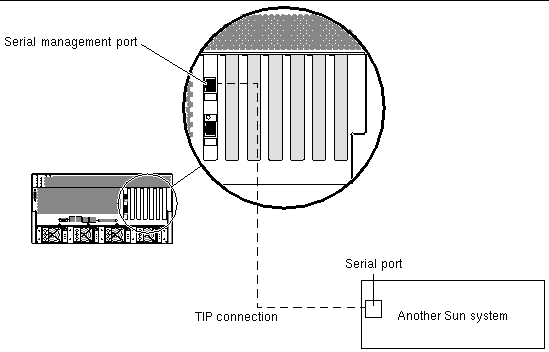
1. Connect the RJ-45 serial cable and, if required, the DB-9 or DB-25 adapter provided.
The cable and adapter connect between another Sun system's serial port (typically ttyb) and the serial management port on the back panel of the Netra 440 server. Pinouts, part numbers, and other details about the serial cable and adapter are provided in the Netra 440 Server Service Manual (817-3883-xx).
2. Ensure that the /etc/remote file on the Sun system contains an entry for hardwire.
Most releases of Solaris OS software shipped since 1992 contain an /etc/remote file with the appropriate hardwire entry. However, if the Sun system is running an older version of Solaris OS software, or if the /etc/remote file has been modified, you might need to edit it. See Modifying the /etc/remote File for details.
3. In a shell tool window on the Sun system, type:
The Sun system responds by displaying:
The shell tool is now a TIP window directed to the Netra 440 server through the Sun system's serial port. This connection is established and maintained even when the Netra 440 server is completely powered off or just starting up.
|
Note - Use a shell tool or a CDE terminal (such as dtterm), not a command tool. Some TIP commands might not work properly in a command tool window. |
4. If you want to use TTYB on the Netra 440 server instead of the serial management port, do the following:
a. Redirect the system console by changing the OpenBoot configuration variables.
At the ok prompt on the Netra 440 server, type the following commands:
|
Note - You can only access the sc> prompt and view POST messages from either the serial management port or the network management port. |
b. To cause the changes to take effect, power off the system. Type:
The system permanently stores the parameter changes and powers off.
|
Note - You can also power off the system using the front panel Power button. |
c. Connect the null modem serial cable to the ttyb port on the Netra 440 server.
If required, use the DB-9 or DB-25 cable adapter supplied with the server.
Refer to the Netra 440 Server Installation Guide for power-on procedures.
Continue with your installation or diagnostic test session as appropriate. When you are finished using the TIP window, end your TIP session by typing ~. (the tilde symbol followed by a period) and exit the window. For more information about TIP commands, see the TIP man page.
For more information about connecting to and using the ALOM system controller, see the Advanced Lights Out Manager User's Guide (817-5481-xx).
If you have redirected the system console to ttyb and want to change the system console settings back to use the serial management and network management ports, see System Console OpenBoot Configuration Variable Settings.
This procedure might be necessary if you are accessing the Netra 440 server using a TIP connection from a Sun system running an older version of the Solaris OS software. You might also need to perform this procedure if the /etc/remote file on the Sun system has been altered and no longer contains an appropriate hardwire entry.
This procedure assumes that you are logged in as superuser to the system console of a Sun system that you intend to use to establish a TIP connection to the Netra 440 server.
1. Determine the release level of Solaris OS software installed on the Sun system. Type:
The system responds with a release number.
2. Do one of the following, depending on the number displayed.
The Solaris OS software shipped with an appropriate entry for hardwire in the /etc/remote file. If you have reason to suspect that this file was altered and the hardwire entry modified or deleted, check the entry against the following example, and edit it as needed.
|
Note - If you intend to use the Sun system's serial port A rather than serial port B, edit this entry by replacing /dev/term/b with /dev/term/a. |
Check the /etc/remote file and add the following entry, if it does not already exist.
|
Note - If you intend to use the Sun system's serial port A rather than serial port B, edit this entry by replacing /dev/ttyb with /dev/ttya. |
The /etc/remote file is now properly configured. Continue establishing a TIP connection to the Netra 440 server system console. See Accessing the System Console Through a TIP Connection.
If you have redirected the system console to ttyb and want to change the system console settings back to use the serial management and network management ports, see System Console OpenBoot Configuration Variable Settings.
This procedure assumes that you are accessing the Netra 440 server system console by connecting the serial port of an alphanumeric terminal to the serial management port (SERIAL MGT) of the Netra 440 server.
|
|
1. Attach one end of the serial cable to the alphanumeric terminal's serial port.
Use a null modem serial cable or an RJ-45 serial cable and null modem adapter. Connect this cable to the terminal's serial port connector.
2. Attach the opposite end of the serial cable to the serial management port on the Netra 440 server.
3. Connect the alphanumeric terminal's power cord to an AC outlet.
4. Set the alphanumeric terminal to receive:
Refer to the documentation accompanying your terminal for information about how to configure the terminal.
5. If you want to use ttyb instead of the serial management port, do the following:
a. Redirect the system console by changing the OpenBoot configuration variables.
At the ok prompt, type the following commands:
|
Note - You can only access the sc> prompt and view POST messages from either the serial management port or the network management port. |
b. To cause the changes to take effect, power off the system. Type:
The system permanently stores the parameter changes and powers off.
|
Note - You can also power off the system using the front panel Power button. |
c. Connect the null modem serial cable to the ttyb port on the Netra 440 server.
If required, use the DB-9 or DB-25 cable adapter supplied with the server.
Refer to the Netra 440 Server Installation Guide for power-on procedures.
You can issue system commands and view system messages using the alphanumeric terminal. Continue with your installation or diagnostic procedure, as needed. When you are finished, type the alphanumeric terminal's escape sequence.
For more information about connecting to and using the ALOM system controller, refer to the Advanced Lights Out Manager User's Guide (817-5481-xx).
If you have redirected the system console to ttyb and want to change the system console settings back to use the serial management and network management ports, see System Console OpenBoot Configuration Variable Settings.
This procedure lets you verify the baud rate and other serial port settings used by the Netra 440 server to communicate with a device attached to its ttyb port.
|
Note - The serial management port always operates at 9600 baud, 8 bits, with no parity and 1 stop bit. |
You must be logged in to the Netra 440 server, and the server must be running Solaris OS software.
3. Look for the following output:
This line indicates that the Netra 440 server's serial port ttyb is configured for:
For more information about serial port settings, see the eeprom man page. For more information about the ttyb-mode OpenBoot configuration variable, see Appendix A.
After initial system installation, you can install a local graphics monitor and configure it to access the system console. You cannot use a local graphics monitor to perform initial system installation, nor can you use a local graphics monitor to view power-on self-test (POST) messages.
To install a local graphics monitor, you must have:
|
|
1. Install the graphics card into an appropriate PCI slot.
Installation must be performed by a qualified service provider. For further information, refer to the Netra 440 Server Service Manual or contact your qualified service provider.
2. Attach the monitor's video cable to the graphics card's video port.
Tighten the thumbscrews to secure the connection.
3. Connect the monitor's power cord to an AC outlet.
4. Connect the USB keyboard cable to one USB port and the USB mouse cable to the other USB port on the Netra 440 server back panel (FIGURE 1-2).
For more information, see Getting to the ok Prompt.
6. Set OpenBoot configuration variables appropriately.
From the existing system console, type:
7. To cause the changes to take effect, type:
The system stores the parameter changes, and boots automatically when the OpenBoot configuration variable auto-boot? is set to true (its default value).
|
Note - To store parameter changes, you can also power cycle the system using the front panel Power button. |
You can issue system commands and view system messages using your local graphics monitor. Continue with your installation or diagnostic procedure, as needed.
If you want to redirect the system console back to the serial management and network management ports, see System Console OpenBoot Configuration Variable Settings.
The Netra 440 system console is directed to the serial management and network management ports (SERIAL MGT and NET MGT) by default. However, you can redirect the system console to the serial DB-9 port (TTYB), or to a local graphics monitor, keyboard, and mouse. You can also redirect the system console back to the serial management and network management ports.
Certain OpenBoot configuration variables control from where system console input is taken and to where its output is directed. The table below shows how to set these variables in order to use the serial management and network management ports, TTYB, or a local graphics monitor as the system console connection.
The serial management port and network management port are present in the OpenBoot configuration variables as ttya. However, the serial management port does not function as a standard serial connection. If you want to connect a conventional serial device (such as a printer) to the system, you must connect it to TTYB, not the serial management port. Refer to the Netra 440 Server Product Overview for more information (817-3881-xx).
It is important to note that the sc> prompt and POST messages are only available through the serial management port and network management port. In addition, the ALOM system controller console command is ineffective when the system console is redirected to ttyb or a local graphics monitor.
In addition to the OpenBoot configuration variables described in TABLE 1-4, there are other variables that affect and determine system behavior. These variables, which are stored on the system configuration card, are discussed in more detail in the Netra 440 Server Product Overview (817-3881-xx).
Copyright © 2004, Sun Microsystems, Inc. All rights reserved.